A few things first:
- It is always good to consider the light issue. Plants need at least 3-4 hours of sunlight every day.
Considering your bedroom’s location and window arrangement can help you get the light requirement for your plants. - Next, pay attention to ventilation. If plants don’t get enough air, they might be damaged by fungal diseases and pest infestation (although some are less vulnerable). You should also make sure that you put plants that need high humidity levels away from air conditioning or heaters.
- Avoid placing plants in direct sunlight. You must put them away from scalding hot lights, but also keep in mind that too much sun can damage the stem of your plants.
- Avoid water damage. Your plants need to be adequately watered, especially during summer when they need more water than other seasons. Before watering your plants, check them for drooping leaves and wilting vines. If necessary, give your plants a bit of extra water to make sure you won’t run out of water during the summertime.
If you are typically a plant parent, this might be one of your most prominent dream: waking up and seeing the greens in front of you.
Well, you can probably try to make it true by placing some plants in your bedroom. But, of course, you cannot just carelessly load them in. Before investing in more plants for your sleeping space, take a look at these 10 Bedroom Garden Ideas below. As always, you can find the detail by following the Simphome link under the reference area:
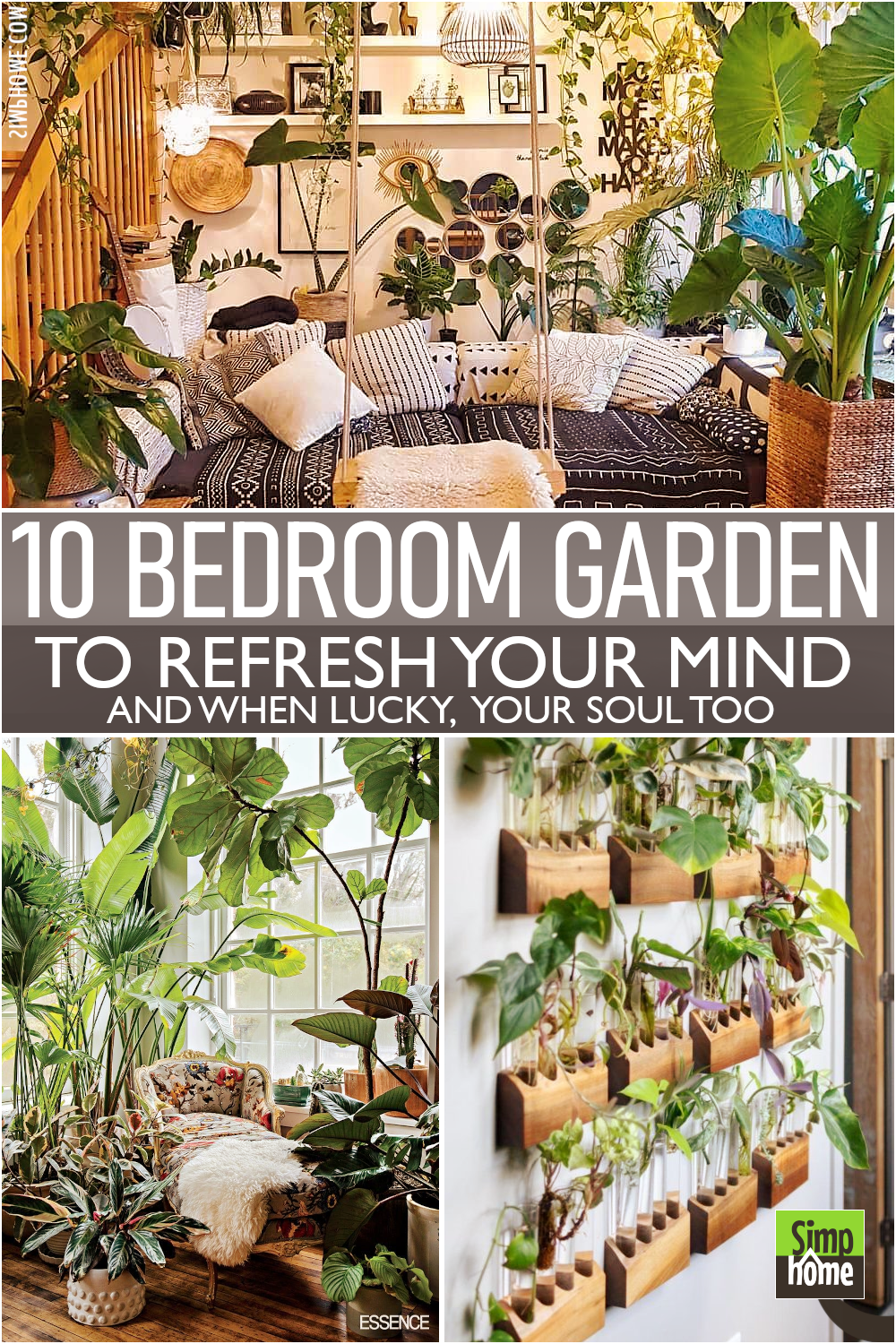
🔊10 Bedroom Garden Video:
List Entries:
10. A Wondrous Propagation Station
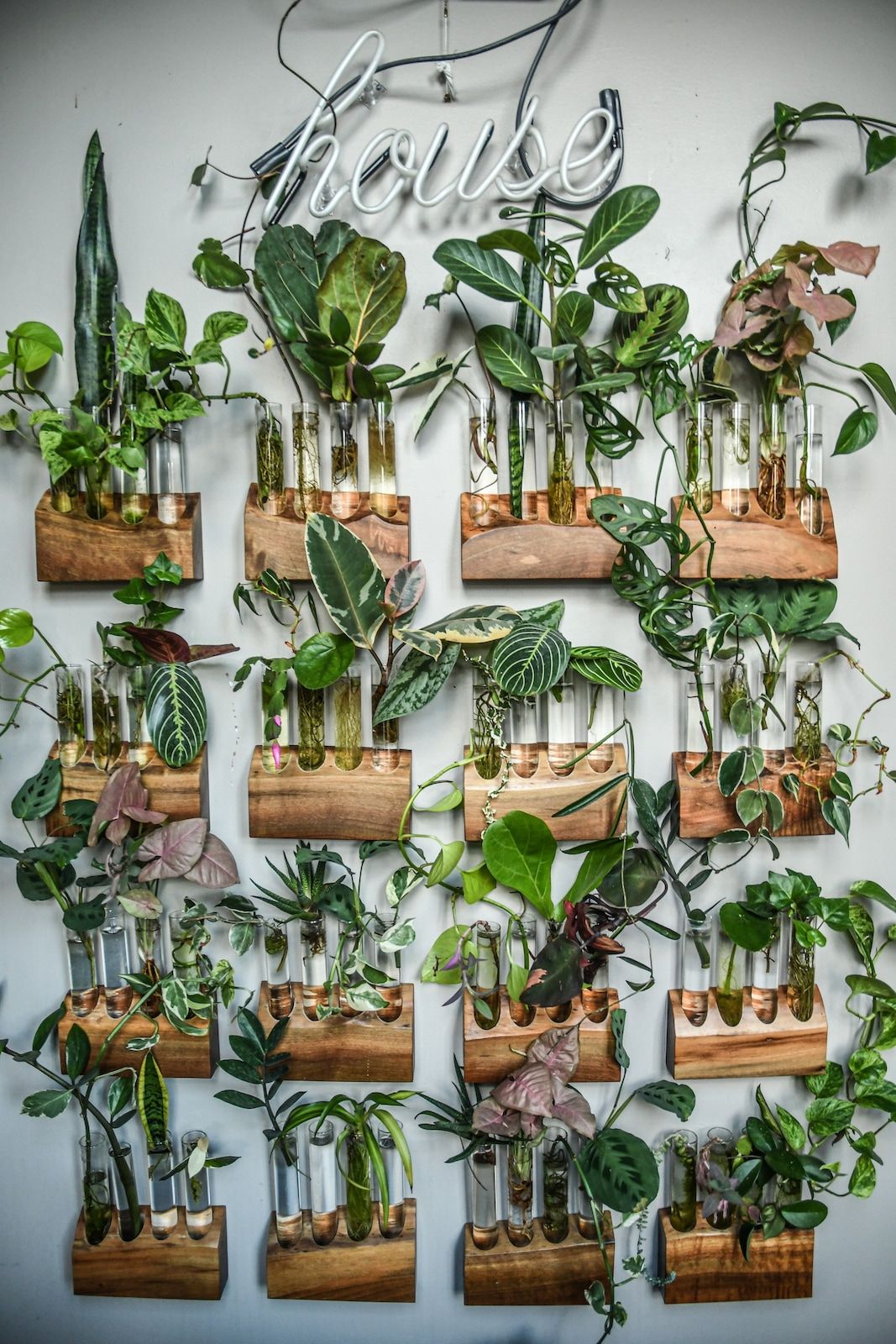 If you have a blank space wall, this idea might be something you can try. You don’t need to worry about watering or fixing the contaminated soil of your potted plant.
If you have a blank space wall, this idea might be something you can try. You don’t need to worry about watering or fixing the contaminated soil of your potted plant.
A propagation station can be functioned both as decor and a medium to propagate your plants. It is a straightforward and cheap way to grow some plants indoors despite the limited space. You can apply this procedure to your pothos or ZZ plant.
If you think that getting a set of test tubes is somewhat arduous, try to upcycle your unused stuff like light bulbs or any glass jar.
Other relevant details:
- Be creative: So many plants can be propagated in a jar like Brussel sprouts and lettuce.
- Lace: Be creative, even with the stuff you don’t use. You can always separate by color or material, give it a new function, or recycle it on purpose.
- Spritz it up: You can use a spray for the bottom part of the jar to keep your plants healthy and moist.
- Hide it: If you want to hide your plant from view, you can cover it with moss (green, not blue) or even flowers as a decoration piece
- Grow it: This is a propagation station. You can use it to grow an indoor plant that you want to keep at home but leave it on the balcony because of the lack of space.
- Hold it up: You can hold up your plant with strings if you are a bit more ambitious. If you want to add some color and pattern, this is an excellent way to show your creativity.
- Grow vertically: This will take a considerable amount of space in your bedroom, but I guess it’s worth the beauty and design plus the money saved by not buying new pot plants.
- Grow horizontally: Another great way to maximize the space you have. I’m sure you can grow your pothos or your other plant in a pot and place it under the lights.
- Make it safe: If you want to ensure that your plant is safe, you can use clear glass. The only concern is that if the light bulb breaks, what will happen?
- Use it as stairs: If you don’t have enough space, you can use the glass jar as a staircase by planting something (flowers) inside the jar and cover with moss or greenery for decoration. This trick is quite a straightforward way to grow indoors if only these ideas above are considered.
9. The Kingdom of Succulent
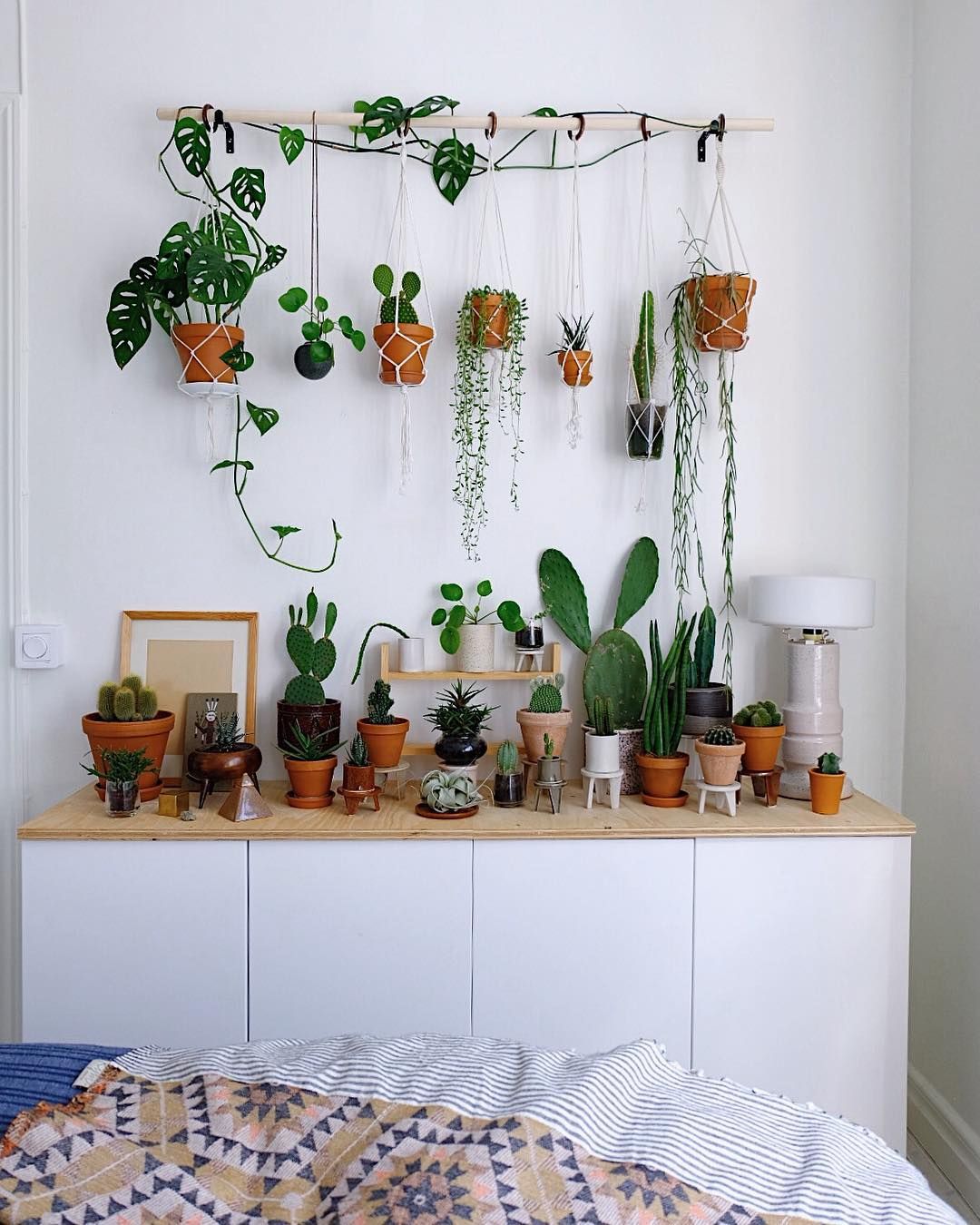 If you are a new plant parent, choosing succulents for your garden bedroom might be the fittest for you. This type of plant doesn’t need much water, meaning you don’t need to worry about the watering schedule.
If you are a new plant parent, choosing succulents for your garden bedroom might be the fittest for you. This type of plant doesn’t need much water, meaning you don’t need to worry about the watering schedule.
There is a limitless variety of succulents. They come in different types and shapes, which will spruce up your bedroom immensely.
Once you get your favorite succulents, now it is time for you to think about how to display them. You can place them near the window. Setting them on the top of the nightstand will also do. Even better, you can hang them on the wall or from the ceiling to create a dramatic look. Arrange them as you wish.
The various shapes and types of succulents inside your bedroom will somehow bring you into a succulent kingdom.
Other relevant details:
- Pot Size:
The size of the pot should be small. This decision is important because succulents are plants that don’t need much space to spread out. Hanging them on the wall also has a small pot requirement. A tiny ceramic container with a hole in the bottom will do for your hanging succulents. - Succulent Container:
Caring for succulents requires more work than caring for other plants, especially when it comes to watering and temperature management.
To ease your task, look for an appropriate container to place your plants and get from somewhere that sells only containers. - Succulent Location:
Succulents will grow best at room temperature, so it is better to place them at the room temperature location all year round. - Succulent Care:
Including some organic potting soil in your succulent container will give your plant proper nutrition and water. You should add soil every week or two depending on how much water your plant needs. - Creating a Succulent Garden:
This is where you can spend more time thinking about what kind of garden you want to create on your bedroom walls, windows, and ceiling and how you will display them. - Seed Starter Kit:
You can buy a seed starter kit for your succulents. This will help you in developing and raising the young ones, which are a bit more tolerant of mistakes than the mature ones. - Succulent Care:
The most important thing you need to do for succulents is to keep the soil always moist. This will avoid them from drying out and dying. You can water your plant using a plant sprayer or by pouring water directly into the surface of the soil. - Here are some other considerations you need to make when caring for your succulents:
A. Succulents grow best at room temperature, around 60 degrees Fahrenheit is a good choice for this.
B. The plant should be kept in a well-lit place but not in direct sunlight.
C. Succulents should be fertilized once or twice a year, spring and fall are the best times to do so.
D. Repotting every once in a while is another thing you need to do, it’s good to remember that this is only necessary if the plant grows too big for its current pot.
E. It is recommended that you re-pot your succulents using a commercial cactus and succulent soil mixture sold in craft stores.
F. Do not overwater your plants as this may cause them root rot and kill them.
G. When watering your plant, leave it alone for about an hour so it will absorb the water well before watering it again.
H. When watering, avoid getting the leaves wet as they are sensitive to moisture and can rot easily.
I. Power outages during the winter can freeze your succulents, so be sure to move them inside during these seasons.
J. It is a good idea to fertilize your succulents at least once a year using fresh soil.
K. Do not use chemicals as they may alter your succulent’s natural appearance and growth patterns.
L. Succulent can grow well in most kinds of soil but will fail if you use water collected from synthetic surfaces like the pavement or the roof because it does not contain the minerals needed for plant growth.
8. The Mini Jungle Idea for the bedroom
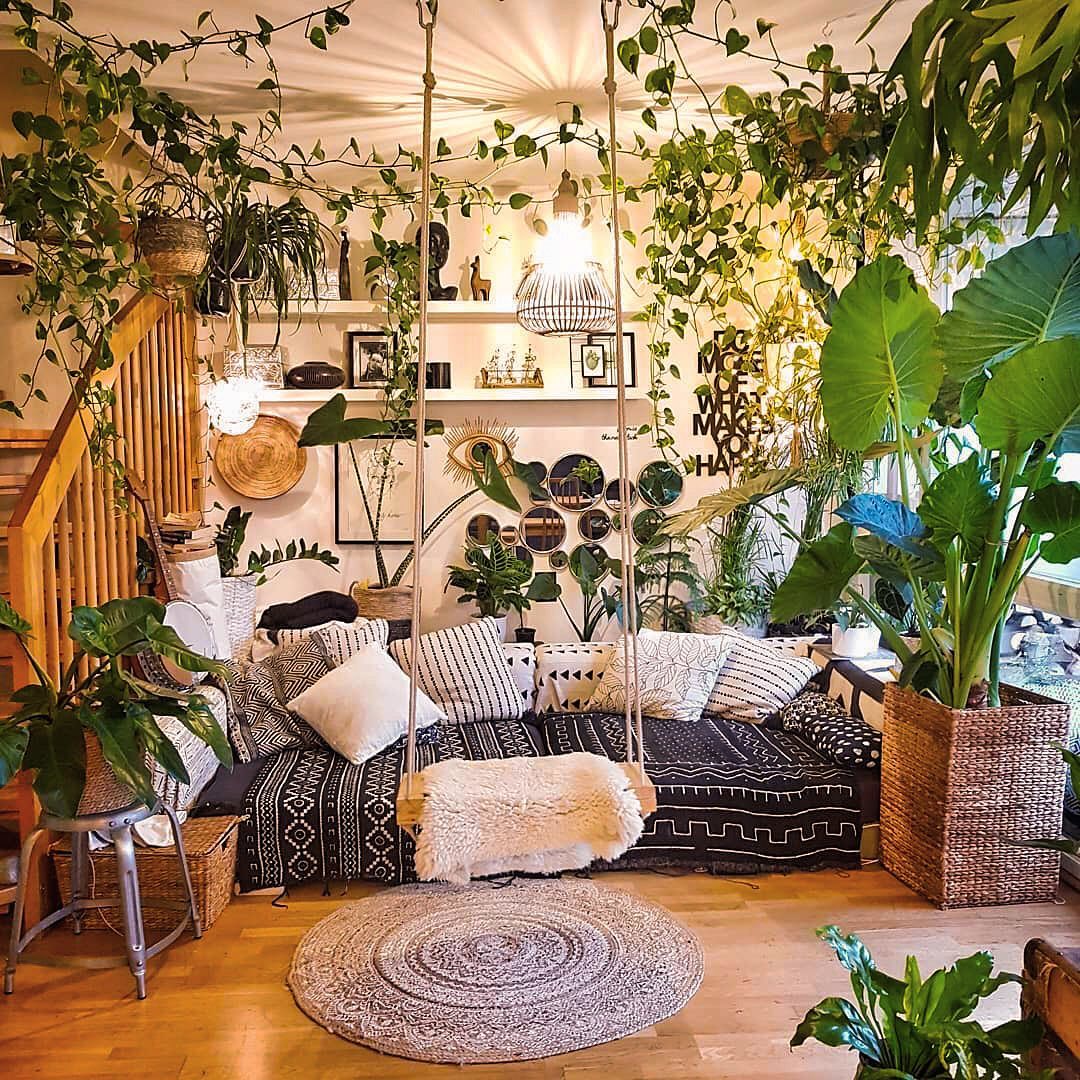 Having a sensation of sleeping in the jungle is likely a dream of plants lovers. Well, that is not just a dream. You can bring the feeling by turning your bedroom into a mini jungle.
Having a sensation of sleeping in the jungle is likely a dream of plants lovers. Well, that is not just a dream. You can bring the feeling by turning your bedroom into a mini jungle.
As the name suggests, it means that the main point is putting plants inside your room as many as you can. You can combine various types of plants. However, it would be best if you made sure to have at least one climbing plant among them. It will help you create more jungle-sensation.
Also, vary the size. Then fill up the room with more plants. Place the big size plants on the floor. You can put the small to medium-sized plants in a rack attached to the wall or hang them. Try not to leave any space.
Still, make sure you have enough space for your mobility.
Moreover, you must be ready to put more effort into taking care of them. Watering, cleaning, and trimming are some regular activities you need to do. But overall, believe that your extra work will be worthwhile.
Step by step to build your first mini jungle:
- Step 1: Decide where you want to have your mini jungle. You have options that include the table, window, shelves, and floor.
- Step 2: Fill up the space with more plants: the more plants you choose, the better creating a miniature jungle in your bedroom. When you like them all, choose about 5-10 of them.
- Step 3: Start watering and trimming regularly – Re-water each plant every week or two if necessary. Trim their leaves and stems if they grow too big for their pot or the floor.
- Step 4: Be aware of them – Notice the changing seasons and weather conditions. When it rains, leave the windows open. Let the plants rest at a shaded spot when the sun is hot.
7. How to have a variety of Tall Plant Inside the bedroom
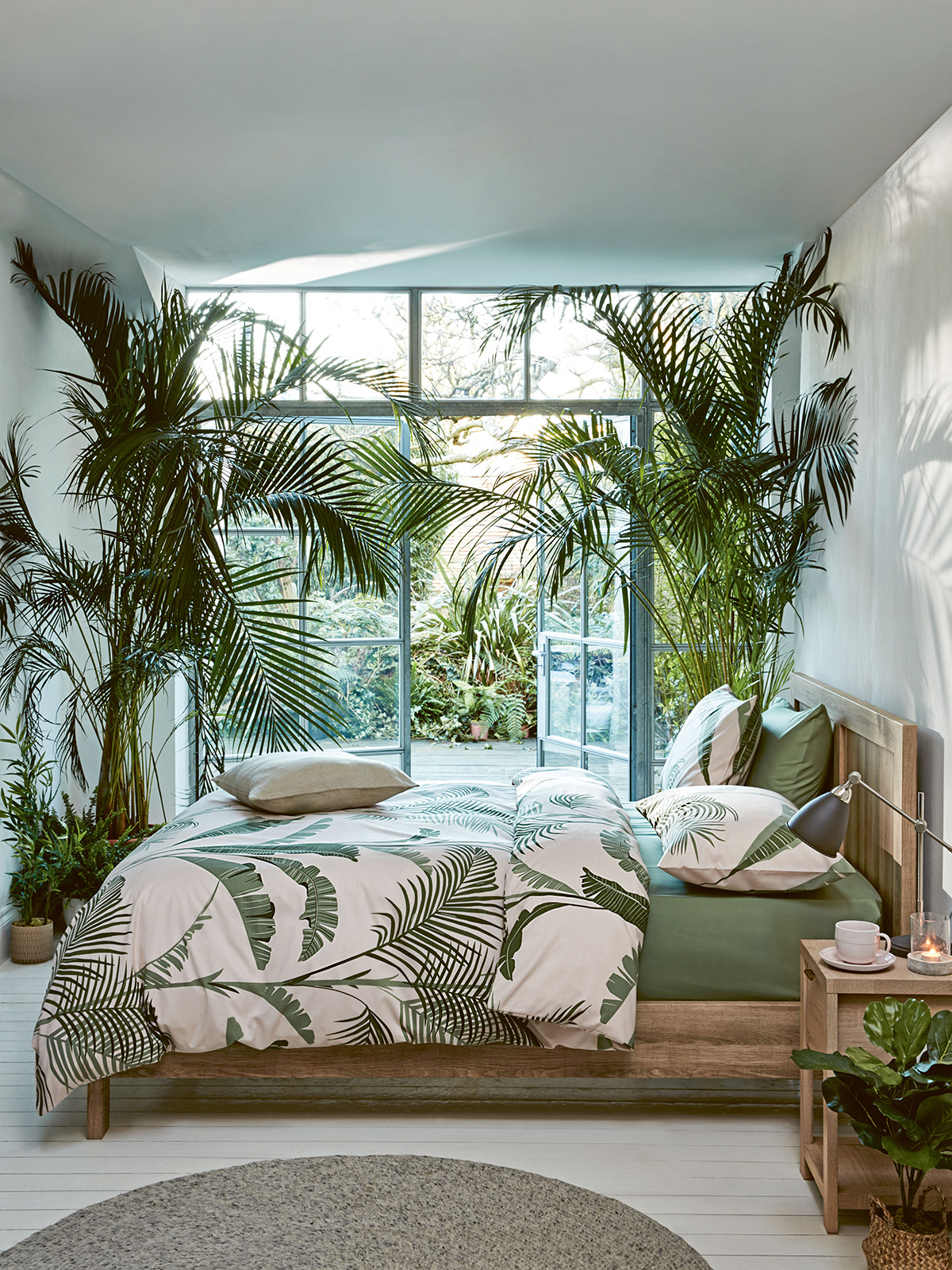 Tall plants would be perfect for the empty corners or tall walls of your room.
Tall plants would be perfect for the empty corners or tall walls of your room.
You can buy different indoor tall plants based on your home decor style. If you want a tropical feel, choosing palms or Birds of Paradise Plants should be in your consideration.
If you want to create a country home feel, then consider purchasing some different small tall plants like a Rubber Plant, Arrowhead Plant, and also some indoor smaller succulents like Blossfeldia Tenella.
Be sure to choose plants that can take up less space as well. Also, consider buying plants with similar colors and textures so that you would unify your arrangement. You can use tall plants such as Tall Christmas Palm, Encephalartos Paniculatus, and some other house plants for the tall indoor plant.
If you have a small garden space, consider planting just one of these plants there.
Just make sure to give that plant plenty of sunlight and some water to see the plant growing.
Tall indoor plants are easy to manage and can be moved around. Just make sure to keep them away from heat sources.
Also, plants such as Pachira Aquatica with its tiny leaves that provide shade or privacy can be used for this purpose. You can place them at the corners of your room or on top of your dresser at night time. They would be your great decorative plant without taking up much space in your home.
6. Get Some Natural Air Purification
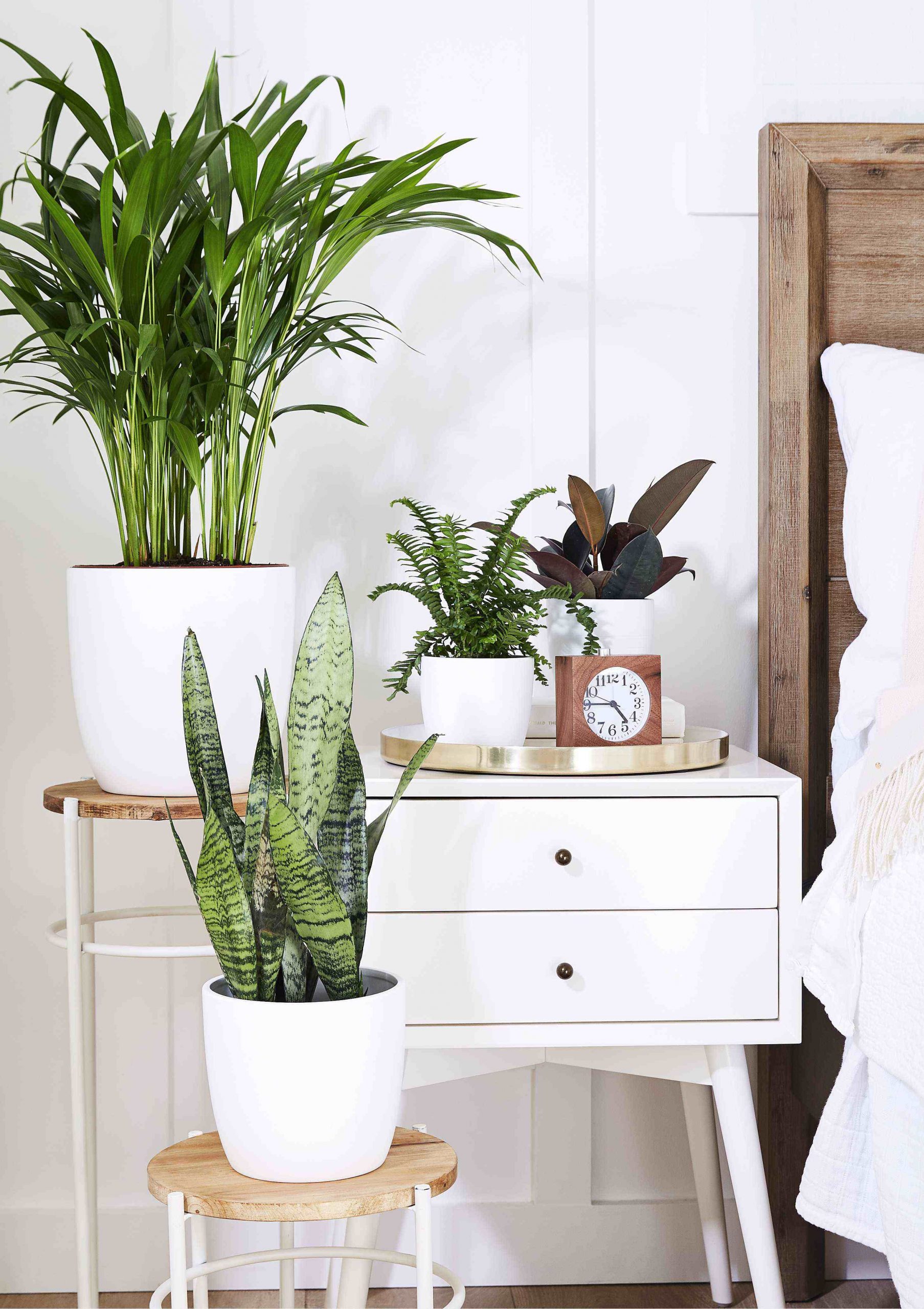
There are some types of plants that can help you purify the air. One of the most notable is snake plants. It will help you remove formaldehyde, a chemical primarily found in conventional personal care and cleaning products.
In addition, this type also can absorb carbon dioxide and release oxygen at night. That is a unique ability compared to other purifying plants, which mostly do those activities during the day. Keeping one in your room will give you cleaner air and more oxygen to breathe in while you sleep.
Other relevant details:
- Snake plants are straightforward to look after. They will not demand much of your time, yet they can improve the air quality in your room.
- They look pretty cool, with their slender but tall leaves growing out of their upright stem.
- It only needs minimal care to stay healthy and beautiful, so you can focus more on other things you have to do in the day.”
- It’s important to know that the snake plant is toxic, so kids and pets should not contact this plant.
- It’s best to place it in the bedroom you often use, but it can also do well in other rooms where you can see it.
- If you want to care for them right, keep them out of direct sunlight and drafts.”
- Alternative to snake plant: You can also fetch the following plant: “big leaf dracaena, golden pothos, and lucky bamboo.”
- Snake plants are pretty tough, but they can tolerate any environment as long as it’s clean.
- It doesn’t like to be transplanted, so you should get one that already has a big pot and leave it there.
- Over-watering is the most common mistake in caring for snake plants.”
- If you have young kids and pets or have a busy lifestyle, this plant is not for you because snake plants do not like moving around or being constantly disturbed.”
- Growing spider plants indoors can be tricky because you need to keep the temperature between 60 and 65 degrees Fahrenheit (15 and 18 C) over winter.”
- You can use a box with pebbles as an alternative planting container for growing it inside your room.”
5. Hang the Plants
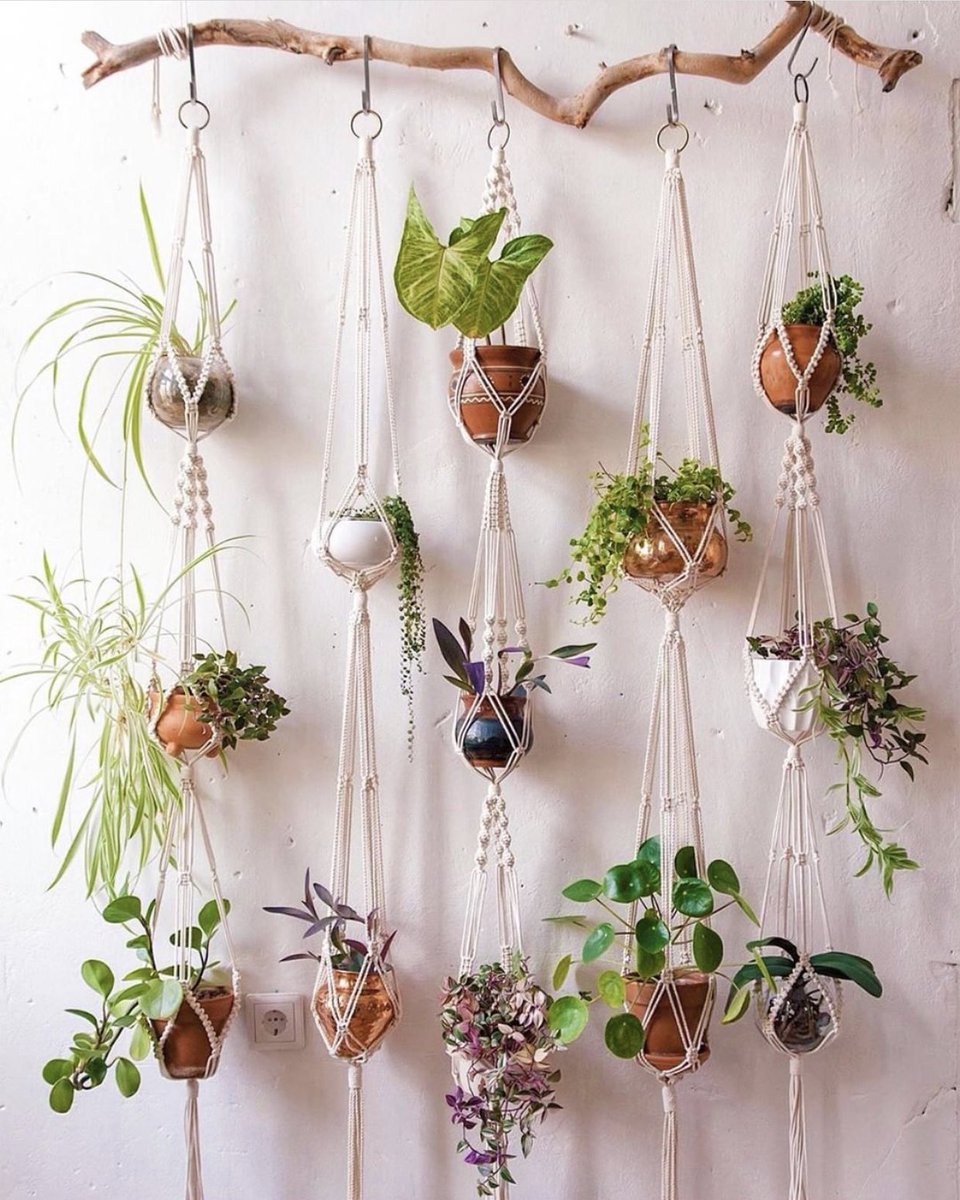 If you don’t have ample space for your plants, please do not worry. You can just hang them against the wall or on the ceiling.
If you don’t have ample space for your plants, please do not worry. You can just hang them against the wall or on the ceiling.
You can DIY the plant hanger. There are thousands of ways of it, like building some shelves, hanging a pegboard, or screwing eye hooks to the ceiling to suspend the pots from it.
You can choose the easiest one or any of them that you are interested in. The most popular DIY way to hang pots is hanging the pot over a hook. It is simple to use, and you won’t find too much hard work.
First, check whether your wall can bear the weight of the pot. If it won’t, then you can try some other ways.
You can build a rack or make a hanger from a wooden board and screw it onto the wall with the help of screws or nails. You can also tap one end of an upside-down cupboard hanging on hooks into your wall to create a sturdy hanger for your plants.
Other relevant details:
- You should hang the pot with its top at about eye level.
- Make sure that the plants hang from a strong hook and not above any windows or doors.
- Avoid putting your plants too close to heating vents as they tend to dry out the air from around them and can eventually kill them.
- Plants enjoy plenty of indirect sun, so hang them in a place with plenty of light, but that isn’t in direct sunlight for most of the day.
- It’s great if you can use a combination of different techniques to create a multi-level plant shelf.
- Consider using a pot hanger with a watering system that helps you water your plants with ease and convenience.
- If you have pets, hang the plants out of their reach so they cannot chew on them or knock them down.
- Put more light on the plants if they are not getting enough light, and consider re-potting if they are growing too long in a small pot (which means they outgrew it).
- Keep the plant pots free from algae build-up by cleaning them every month or so. You can use vinegar and water, salt water, or a rough scrubby sponge to do this.
- Avoid using detergents because they can cause damage to the plant leaves and roots over time.
4. Adding therapeutical Fragrance to your bedroom
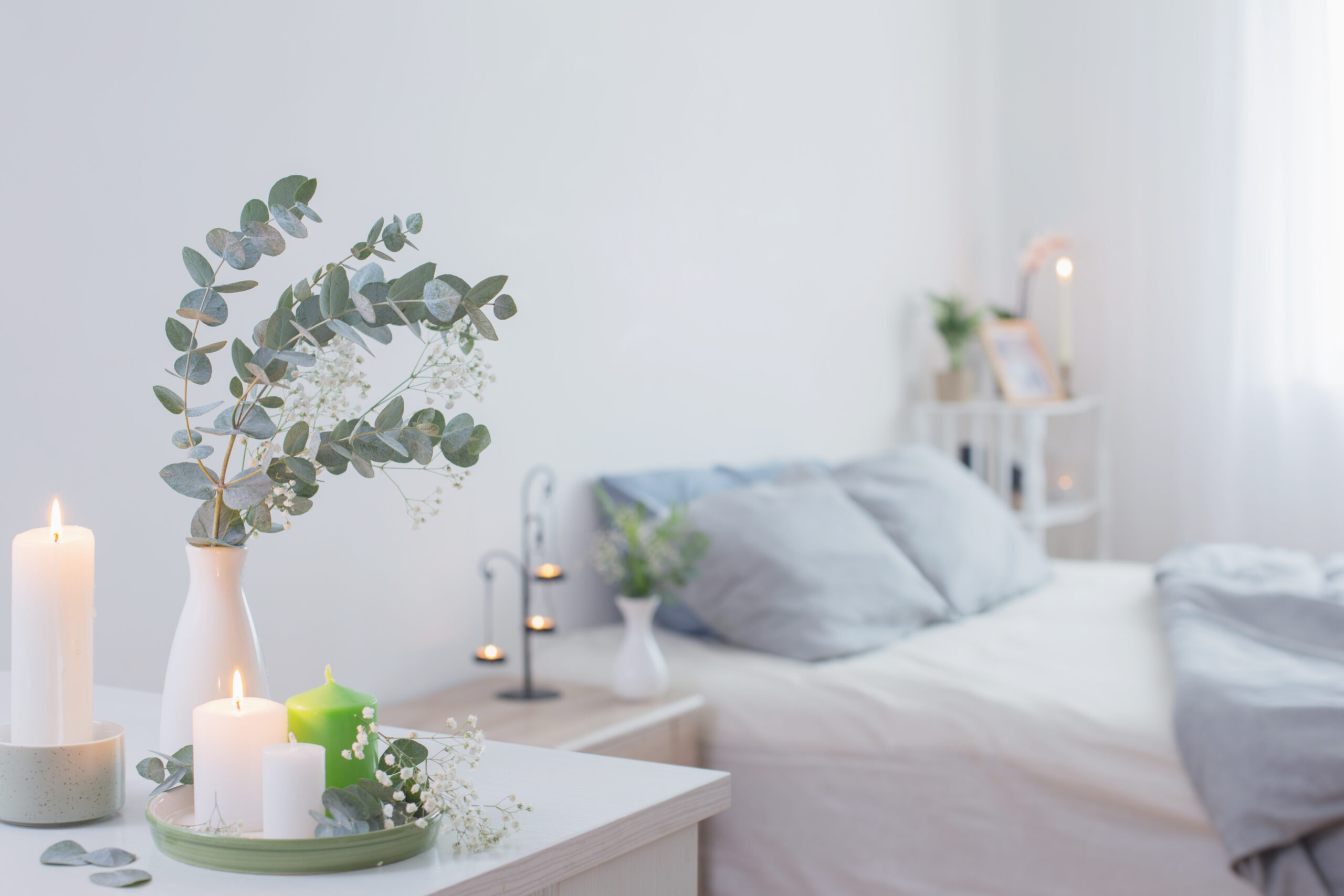
Having a natural fragrance for your bedroom would be terrific since it is a better option for your health. You can add one or some scented plants in your room if you believe so.
There are many types of fragrant plants. One of which is the Eucalyptus. It is easy to grow indoors and prefers either full sun or indirect sun. You just need to keep it pruned and trimmed back so that it stays bushy and full.
Take a note that eucalyptus can’t be forever in a container. It can grow so fast. If it gets bigger and no longer fits in your room, you must take them out, plant them in your backyard or any other open space.
Additional instructions:
- Step 1: Start with garden soil in your pot.
- Step 2: Fill the soil in your container with fresh water.
- Step 3: Add water until it’s about half-filled.
- Step 4: Add organic fertilizer to fix the soil’s pH level.
- Step 5: Plant your cuttings.
Ideally, you need to plant eucalyptus seeds and keep them at least 10 inches away from each other to create air space between them. - Step 6: Place it near the window — preferably facing south to get more sunlight. Make sure it sits on a watering mat to help keep the plant moisturized (Do not overwater).
- Step 7: Water it twice or thrice a week.
Remember that eucalyptus doesn’t like overwatering! Pour the water little by little and make sure that no more water is coming out of the bottom potting soil until it sinks down. If you see that too much water comes out at once, do not worry! It might be because of an over-watering error. Simply take out most of the water until only a little bit is left. Put it back on the watering mat, wait until it dried, then try again. - Step 8: If you want to add some decorative element (such as a plant or flower) to your eucalyptus, feel free to do so! However, make sure it does not have any chemical substance; you must use organic flowers and plants.
- Step 9: Also, for those who love fresher air in the room more than scented plants, you can have a humidifier in your room. This trick will bring a more hygienic and healthy environment by releasing moisture into the air.
- Step 10: As you plant it, try to touch and move your eucalyptus a little bit. However, do not overdo that and kill your plant!
- Step 11: After three months have gone by; you need to trim your eucalyptus. When trimming, make sure it doesn’t go too far down so that it can “bleed.”
- Step 12: Try not to touch the leaves of your eucalyptus because they are susceptible.
Extra:
Forget about the plastic pots; you can use a decorative basket instead. It will still look excellent and adorable on the floor or the dresser! However, do consider that you need to water them regularly and make sure it is still in good condition. Do not overwater them either.
3. A Living Wall
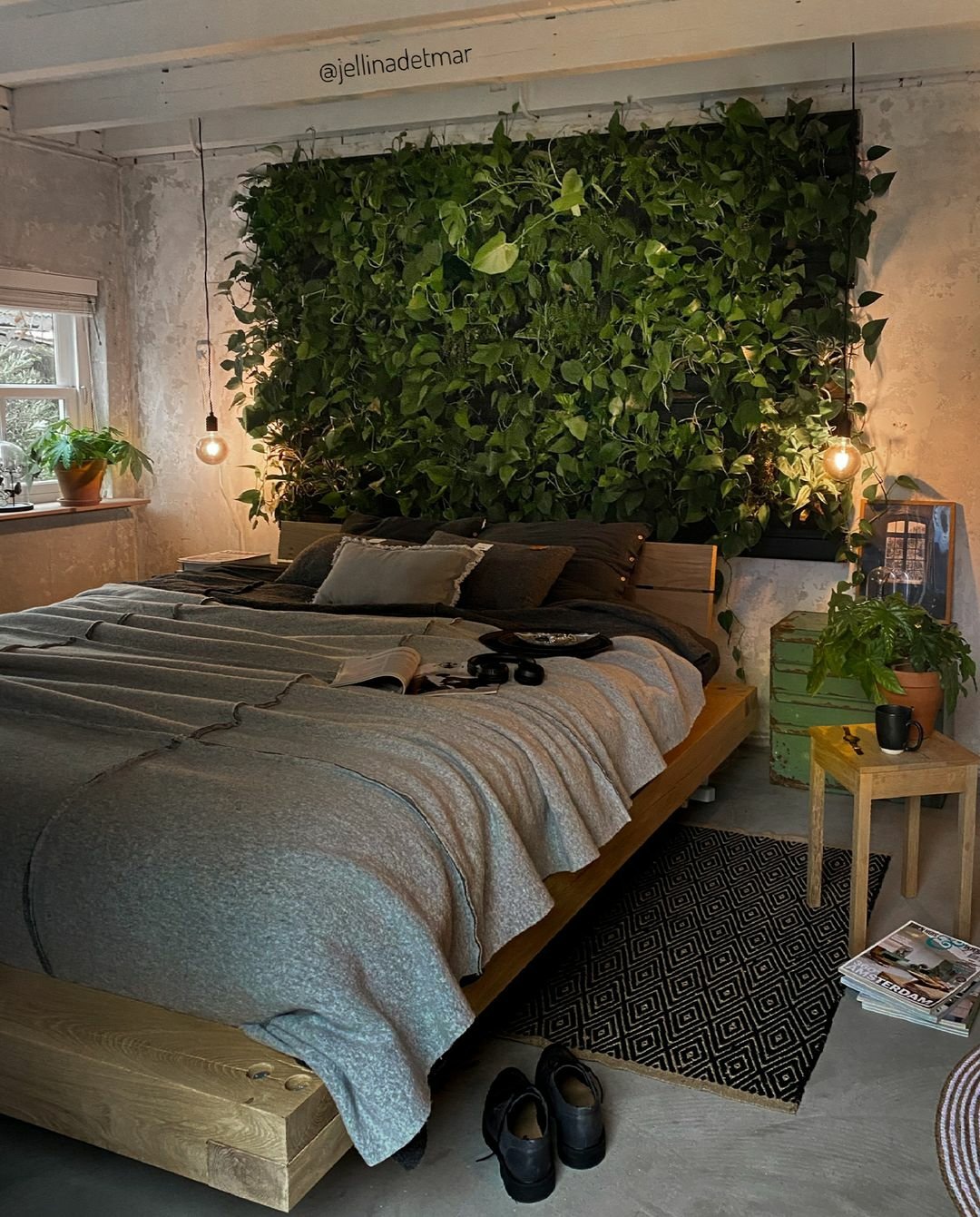 Don’t leave your wall empty. Try to build a living wall at least on one side of your room’s wall.
Don’t leave your wall empty. Try to build a living wall at least on one side of your room’s wall.
The main concept of the living wall is to garden vertically. The easiest way is to purchase a pocket indoor waterproof planter. But if you want to DIY it, build a wood frame, staple wire mesh onto one of the sides, then hang some plants on it.
Make sure that the plants cover all the area. Plus, it would be best to grow vines and climbers, such as philodendrons, pothos, English ivy, Peperomia varieties, and many others.
Other relevant details:
- Put plants in each corner of the room to not touch the walls and create a gradient effect from left to right.
- Use several different types of plants.
- You can also use a climbing wall so that you can easily change and add new pots without damaging your living concept wall.
- If you have a small space, don’t be too lazy to design it impressively by using your original concept and imagination instead of investing in more plants.
You can make this for yourself before even thinking about buying more plants for your garden and enjoying the benefits thereof! - Continue with the living wall design from your home exterior, such as in a balcony. Use vines or climbing plants on your wall and enjoy the view you have created for yourself!
Construction instructions:
- Start with a good potting mix.
- Select the plants that you want to use.
- Make sure they are healthy and have no disease or pests.
- Line the inside of the wooden frame with some wooden slats or boards (for vertical supports).
- Start sticking your plants to wire mesh using a small amount of glue or hot glue gun, taking care not to let any excess drips on your plants!
- After your plants are in place, cover the frame with a piece of gauze so that your garden doesn’t get wet overnight.
- Add another layer of the fence on the outside, this time using wooden slats or boards.
- Place it in such a way that it sticks just below your skylight or window (if possible) but does not obstruct it.
- Add more plants as you like (at least one per every two square feet).
- Continue adding layers of plastic to the top and bottom, which will help to prevent drips from happening during the night (if you don’t have a skylight or window over your balcony).
- Place a hose on the top of your balcony or roof and let the water drip from it slowly through the system.
- If you live in a cold place and worry about snow or frost damage, use a small heating cable (throughout your balcony) to keep it warm and not subject to below 0F temperatures.
- Enjoy watching your living wall flourish!
If you have limited space in your bedroom, try to build a mini garden bed and place it inside the main one. You can either place it in the corner of your bedroom or in front of the window, or door (if you have any)
2. Plant The Headboard
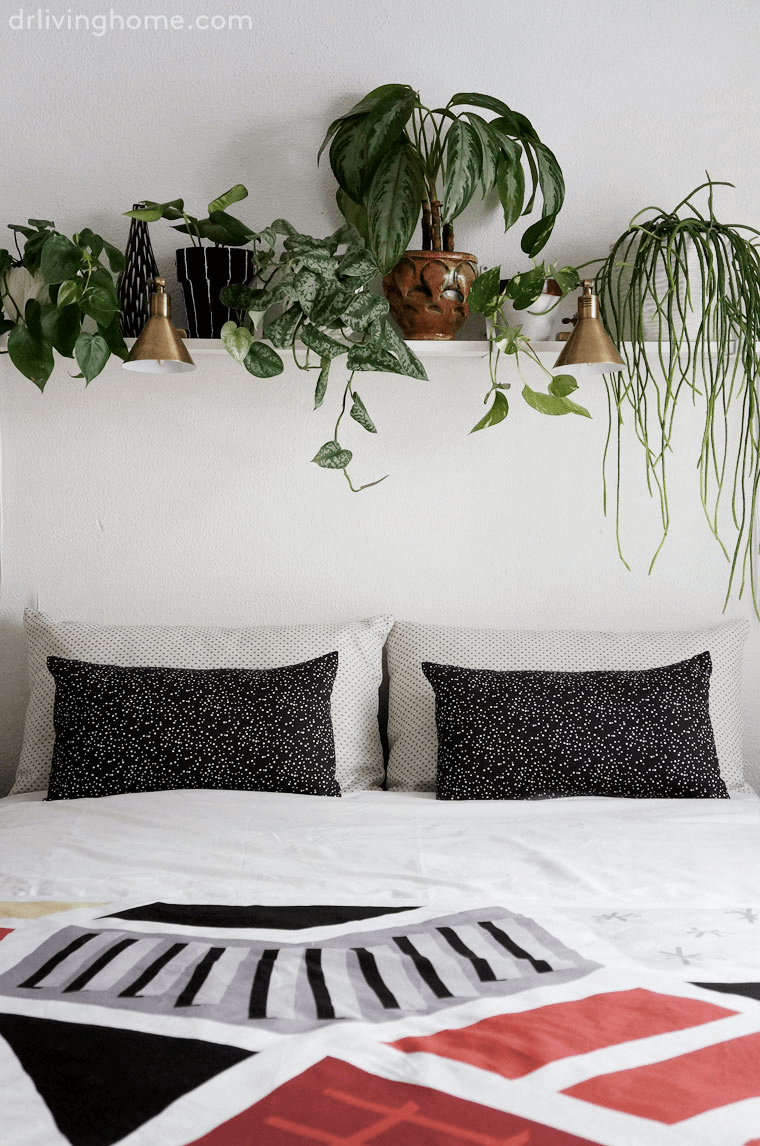 This idea is super easy to do. You only need to install a single wooden shelf above your bed. Make sure that it sticks to the wall firmly.
This idea is super easy to do. You only need to install a single wooden shelf above your bed. Make sure that it sticks to the wall firmly.
Then place some potted plants on the shelf. Any plant will work. But, don’t put too many because they will be too heavy.
Some of the recommended plants you can use to enrich your headboard such as :
– Geraniums
– Pampas Grass
– Bamboo (if the plant is not too thick)
– Marigolds and Petunias
– Lilies
– Various Borage species
– Asters are also good choices.
If you want to be extra creative, try planting some herbs or banana plants for your headboard. You can also use plants that offer different colors, such as red, blue, or purple plants.
To care for and tender a headboard completed with more than one indoor plant, you must place a small basket and plants on the shelf.
Place some potting soil on the basket so that it is not too heavy for the plants on the shelf.
Then start watering your plants regularly, once a week. You can also sprinkle some water on the basket when it is needed.
When you are happy with your indoor garden arrangement, you can put some fruits (apricots, peaches) or some jam containers on your headboard with flowers, or they could be green vases to match your bedroom’s color scheme as well.
Lastly, Number 1. How to enrich your minimalistic bedroom with The Potted Plants inside
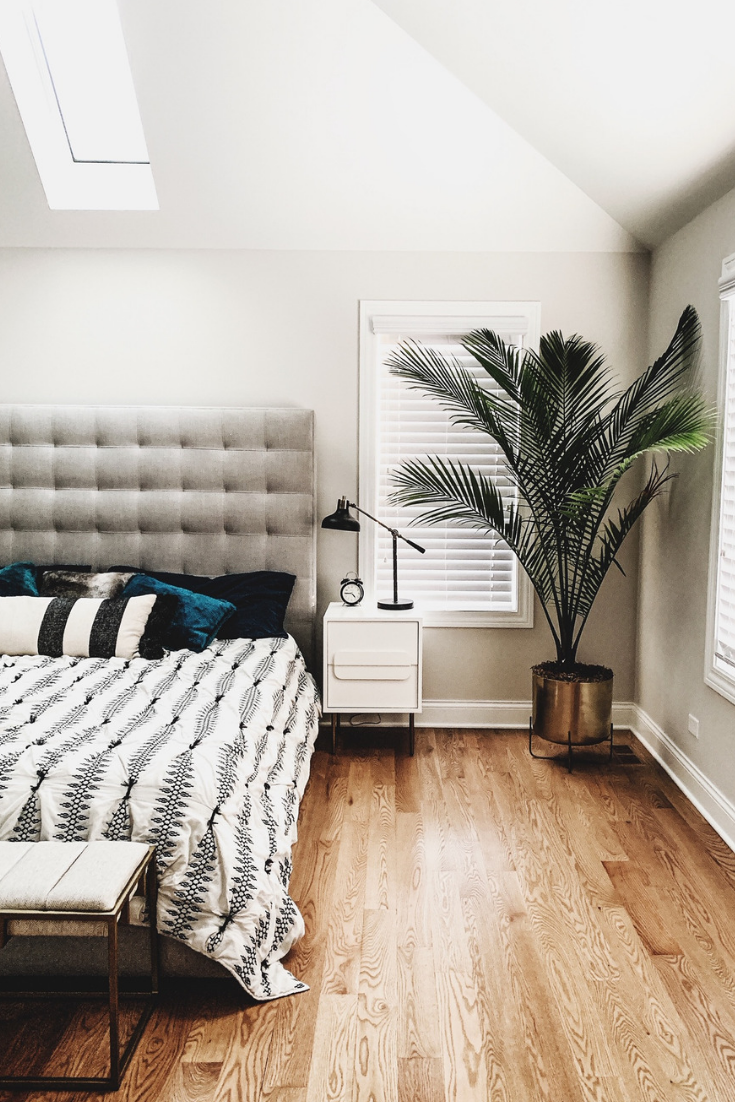 If you’re typically someone who prefers a modern minimalistic design, this idea will probably still work. You just need a potted plant and place it in one of the corners of your bedroom.
If you’re typically someone who prefers a modern minimalistic design, this idea will probably still work. You just need a potted plant and place it in one of the corners of your bedroom.
You had better pick a big-sized plant because it simply offers a statement into your room without overwhelming your bedroom.
Detailed Instructions:
- Step 1: You need a big-sized potted plant you feel comfortable with. It might be better to go for indoor plants since they are easier to handle.
- Step 2: Start by placing the potted plant in a corner on the floor. Then, arrange your bed and other furniture around it. The placement should look pretty good as well as balanced overall.
- Step 3: Add the accent lamp on your nightstand to create a cozy and warm ambiance.
- Step 4: If you think the planter is too big for your bedroom, you can get it reduced by placing some decorative boxes or objects on top of it. The placement is meant to help hide the big-sized container, of course.
- Step 5: Add some plants near the big plant, such as the smaller-sized ones.
You will then accomplish the idea of creating a mini garden inside your room. - Step 6: If the small-sized plants are not enough, you can also add larger ones.
Simply plant these in another corner. They still need to be placed in a balanced way, though. - Step 7: A beautiful view of your flower garden is available for you whenever you turn around on your bed itself.
To make it look even better, you can apply more lighting to it and the bedding. You might also add something splashy and colorful as a contrast if it fits into the theme of your room. - Step 8: If you want to provide extra storage, you can plant some small-sized planters on the top of your bedside chest. The idea is to create a vertical garden inside your bedroom. Yes, it will be pretty admirable.
- Step 9: You can also place some potted plants on the floor in front of your bed.
It offers a whimsical touch that will surely improve your room’s overall appearance. - Step 10: If you like to make a statement, you can use a hanging plant in one of the corners of your room.
The plant should be big enough to fit into it normally. Repeat the whole process as many times as you want to accomplish harmony throughout your room in general.
Conclusion:
So, are you ready to have your very own bedroom garden?
You can also tell your friends about this idea. They might need it. And for sure, you will not regret having added some living green elements into your sleeping space.
Maybe this idea can also work for you since it is very versatile and flexible to adjust to different types of design.
If you do not want to create a miniature garden inside your room, the potted plant option might be enough to turn the corner dull into something alive.
Those are ten-bedroom garden ideas that any plant parent can copy. Decide which one suits you the most. And take your action now!
References:
9. Pinimg.com
8. Amethyst-organic.tumblr.com, Pinimg.com
7. Hgtv.com, Dailymail.co.uk
5. Pinimg.com, Apartmenttherapy.com
4. Pinimg.com, Smartgardenguide.com
3. Pinimg.com
2. Pinimg.com, Drlivinghomedecor.com
1. Hgtv.com, Firstthymemom.com